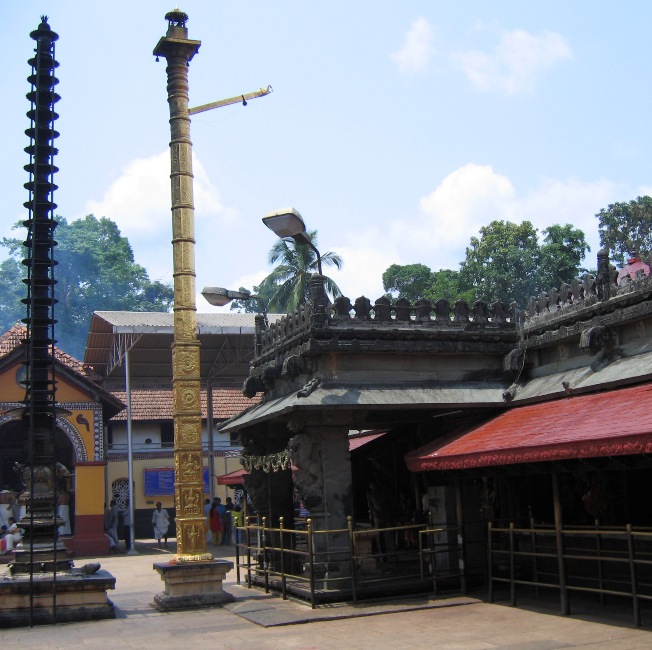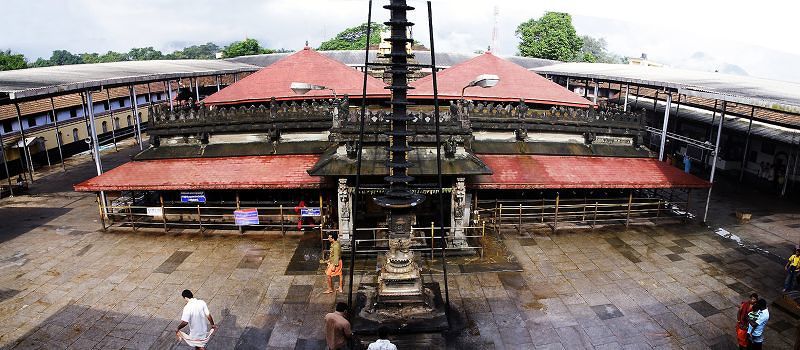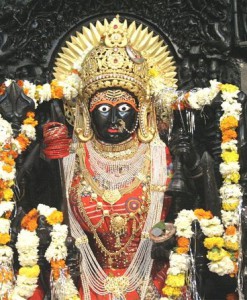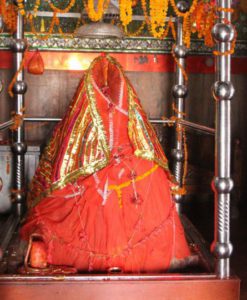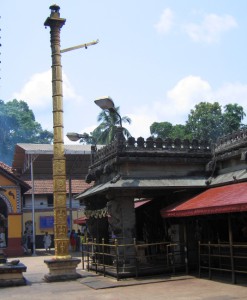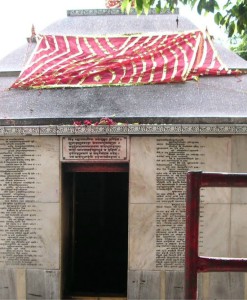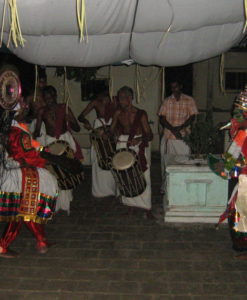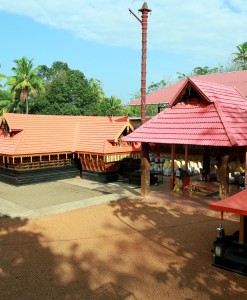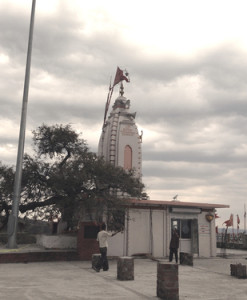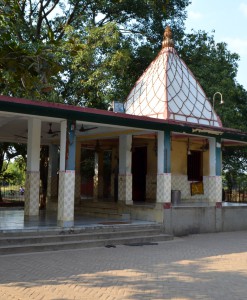No products in the cart.
The Mookambika Temple is located in Kollur of Udipi district in the Southern state Karnataka. Kollur is at a distance of about 135 kms from Mangalore. It is the only temple which is dedicated to Goddess Parvati and is believed to be built by Parshuram. The people of Karnataka are very fond of this temple and the Goddess Parvathi is called in Tamil as Thai Mookambika. Parvathi temple is located exactly on the banks of the perennial river Souparnika that runs close to the foot hills of the Western Ghats. River Sauparnika has its connection to the eagle called Suparna that did penance in this bank and attained salvation. Kollur is regarded as one of the Seven Muktislala pilgrimage sites in Karnataka which are (kollur), Udupi, Subrahmanya, Kumbasi, Kodeshwara, Sankaranarayana and Gokarna.Kollur is known for its association with Aadi Sankara.
The establishment of Mookambika temple is attributed to Parameshwara, who has drawn a chakra with his toe. History of the temple begins with the arrival of sage Shankaracharya at this place in 8th century A.D. Historically it is believed that this place was inhabited by Shakthas called Kaulas and that was how this place came to be called as Kollur. Honneyakambali Kings of Hosangadi have been ruling Kollur and they were ardent devotees of Mookambika. King Halugallu Veera Sangayya is said to have laid the foundation of valuable stone to cover the inside premises and this was done by him under the instructions of Rani Chennamaji. The Mookambika temple has been graced by many ancient kings who donated various precious jewels to Sri Kollur Devi and they are still adorned by her. Many other Hindu kings have also donated to this temple since it was believed to be the state temple in those days and was an emblem for Goddess Parvarti.
Architecture of Temple:
The architecture of the Kollur Sri Mookambika Temple Temple belongs to the Keladi period. Recently the Temple was renovated. The Sanctum Sanctorum which is in a Quadrangular shape has a tower known as Vimana Gopura which is in the Dravidian Architecture. The tower of the sanctum sanctorum is covered by gold donated by local king centuries ago. Around the sanctum sanctorum of goddess Devi, we can see the retinue deities like Subrahmanya, Dashabhuja Ganapathi, Anjaneya, Chandramouleeshwara, and Gopalakrishna. The statue of Mookambike is very attractive and has four arms The upper two arms are holding Shankha and Chakra and the palms of the lower two arms.
Sri Mookambika Temple, Kollur, Karnataka
The legend says that there used to live a demon named Kaumasura. He was creating a reign of terror upon all the gods with his special power given by Lord Shiva. When all the gods were trying their best to stay away from his vicinity, Guru Shukracharya brings optimistic information to the gods that this demon would face death by a woman that is Goddess Parvathi. Knowing this Kaumasura undertakes severe expiation. Lord Shiva asks this demon to ask for the boon, sensing grave danger if he his offered the boon, this Goddess of speech makes this demon dumb.
Hence this Kaumasura came to be known as Mookasura (mooka means to be dumb). Thereafter Devi mobilized all the powers of the gods and then this demon was killed by Kollur Devi Parvathi. She was hence forth called Mookambikai. This place where Devi killed Mookasura is known as Marana Katte. Her divine energy became one with the lingam worshipped by Kola Maharishi.
The Kollur Devi then became the deity of this place offering her blessings to all who sought her divinity. She poses with all her vibrancy and grace along with the shank and chakra in both her hands sitting in the padmahasana posture.
Another legend narrates that Adi shankara once worshipped Goddess Saraswati in order to bring her to Kerala, where none of her temples existed. When Devi acknowledged his prayers, he told that he wished to bring her to Kerala. She agreed to come, but only on one condition that when he was going she would follow and if he stops and looks back, she will stay there and will not continue. Adi shankaracharya agreed. So they started walking down from Kodachadri hills. While walking he could always hear her anklets,so he knew that she was with him. Suddenly, the sound stopped. Adi shankara looked back with doubt .When he saw she was still with him, Adi shankara apologized as he had broken his vow .Devi said from now on she will bless her devotees here, in Mookambika. But he was determined to take her to Kerala. On seeing his devotion she agreed to go to Chottanikkara temple in Kerala and return to Mookambika.
First of all the worship is offered to Shree Veerabhadra Swamy and after that, prayer is offered to the Subrahmanya Swamy. The Saraswathi Mantapam is on the southern side of the outer circle and here the ceremony of “Vidyarambha “ or the initiation of learning to children as well as the “Anna Prashana” or first intake of solid food is being held. In addition to that, Music, Dance or other cultural programmes if any, are also takes place in this Saraswathi Mantapam. On the western portion of the outer circle, the small temples for Shree Pranalingeshwara, Shree Partheshwara, Shree Panchamukhi Ganapathi, Shree Chandra Mouleeshwara, Shree Nanjundeshwara, Shree Anjaneya, Shree Venkataramana, and Thulasi Gopalakrishna are available.
NAVARATHRI FESTIVAL:
During the days of Navarathri Festivities, along with the special “Poojas” Shatha Rudrabhishekas andn at the night, “Kalpoktha Navarathri Special Pooja” is performed. During Navarathri, which is celebrated for Nine Days, “Navadurgalankara” is performed. On the Mahanavami Day (the nineth day) Car Festival (Rathotsava) is held by placing the Devi on the decorated Pushparatha. The “Chandi” Sthotra will be read on all the nine days. “ Chandika Homa” also will be performed. The Navarathri Celebrations end on the Vijayadashami day. On the Vijayadashami day, thousands of devotees perform the Aksharabhyasa Seva at the Saraswathi Mantapa.
DHANURMASA :
During the month of Dhanu, every morning the routine poojas will be performed and every day special “Naivedyas” will be offered and “Mangalarathi” will be performed.
SHIVARATHRI:
On the day of Shivarathri, along with the routine Poojas, special “Abhishekas”, “ Archanas”, “Naivedyas” and “ Mangalarathi” will be offered. Along with that, Festivals are also held on the Street Known as “Beedhi Utsava”
THE ANNUAL FESTIVAL:
The Annual Festival is held every year during the month of March or April for Nine days. Daily worship and special processions are held. At noon “ Shatha Rudrabhishekha will be performed”. At 5.30 PM in the evening and at 10.00 PM in the Night, Street Festivals take place. The main Car Festival ( Maha Rathotsava) will be held on the 8th day. Next day the “Okuli Festival” ( like Holi) and the Boat Festival ( Theppotsava) are held on the Sowparnika River. On that day during the “ Maha Rathotsava” the festivitis will be held seating the Devi on the “ Doddatte” (Decoration like the Aura around the Devi)
UGADI:
On the day of Ugadi, the usual Poojas will be offered, with special preparation using Neem. In the evening, from 5.30 PM to 6.00 PM, the Goddess will be placed at the Saraswathi Mantap and special offerings and Mahamangalarathi will be performed, followed by the traditional “ Panchanga Shravana” ( Predictions are made about the Nation, Rain, Agriculture and Politcal Scenario etc. ) This is the beginning of the new year. On the evening of Ramanavami i.e after 15 days from Ugadi, special festivals are held.
ASHTABHANDHA BRAHMAKALASHOTSAVA:
Ashtabhandha Brahmakalashotsava is performed once in twelve years. Last time this festival was held in April 2002 in a splendid manner. “Abhisheka” ( ritualistic bath) was performed on to the Linga with 1008 “Kalashas” ( vessel containing water – of which 1000 were made up of silver and 8 were made up of Gold) filled with sacred water. All the sevas and programmes are taking place during the Brahmakalashotsava Festival. The “Sahasra Kumbhabhisheka was performed in the benign presence of Shringeri Jagadguru Shree Shree Bharathi Theertha Swamiji. The Ashtabhandha Brahmakalashotsava, Ati Rudra Mahayaga, Sahasra Chandi Mahayaga was accomplished with the help of about 200 priests. The “poornahuthi” of the Sahasra Chandika Yaga was performed by Shree Shree Raghavendra Bharathi Swamiji of Ramachandrapura Math.
CHANDIKA HOMA:
The Chandika Homa is performed by about 7 Priests, by reading 700 verses andn 700 hymns from the Shree Devi Mahatme and offering sweet pudding (Payasam) 700 times to the Agni. Every day the Chandika Homa Seva is performed in the Temple
To attain and feel the divinity and purity one should surely visit this temple.
Sri Mookambika Temple pooja timings:
Morning:
5.00 am : The Temple opens
5.15 am : “Abhishekam” to the Lingam
5.30 am : Ganahoma (1 Coconut)
6.30 am : The morning worship ( Pooja) starts
7.15 am : Dantha Dhavana Mangalarathi
7.30 am : Panchamritha Abhishekam
7.45 am: Naivedya
8.00 am: Morning Mangalarathi and “Bali” Utsavam
8.15 am : End of Morning Bali Utsava
From 5.00am to 7.15am and 7.45am to 11.30am Devotees are allowed for “Darshan”
Noon:
11.30 am Noon Pooja starts
12.30 pm maha Mangalarathi and afternoon “Bali Utsava”
1.30 pm The Temple Closes
Noon 12.00 to 12.20 pm and 12.45 to 1.30pm, devotees are allowed for “Darshan” 3.00pm The Temple door opens
Afternoon 3.00 pm to 6.30 pm Devotees are allowed for “Darshan” ( Afternoon 3.00 pm to 5.00pm there can be only “ Darshan” and Sevas will not be performed)
Evening:
6.30 : Pradosha Pooja starts. Panchamritha Abhisheka
7.00 pm: Naivedya
7.15 pm: Mangalarathi
7.30 pm Salam Mangalarathi
7.45 pm Mangalarathi for all accompanying Deities.
8.00 pm Naivedyam, “ Bali” and Mangalarathi
8.15 pm Night “ Bali” Utsava
8.30 pm Utsava Moorthi is placed at the Saraswathi Mantapa, and naivedya with Beaten rice, coconut. After that,Mangalarathi and Ashtavadana Seve Vedaghosha, Sangeetha, Shruthivadya,Sarvavadya). Once it is over Shree Devi will be taken inside the Temple
9.00 pm Kashaya Mangalarathi
Main Bus Stand:
The Main Bus Stand of Kollur is about 500 Mtrs from the Temple.
Main Railway Station:
Kundapura and Byndoor Railway Stations are in a distance from the temple of about 32 Kms and 28 KMs respectively.
Main Airport:
Mangalore Airport ( Bajpe) is about 140 Kms from the Temple

